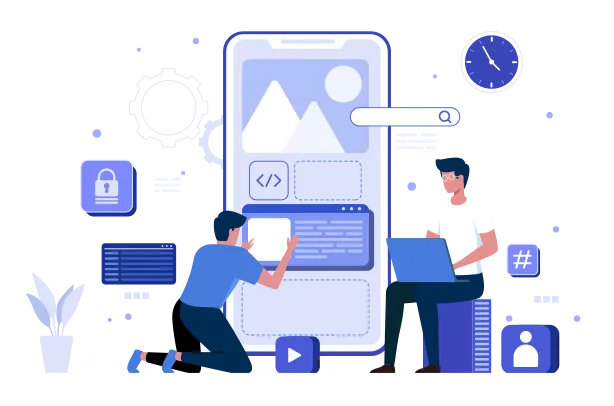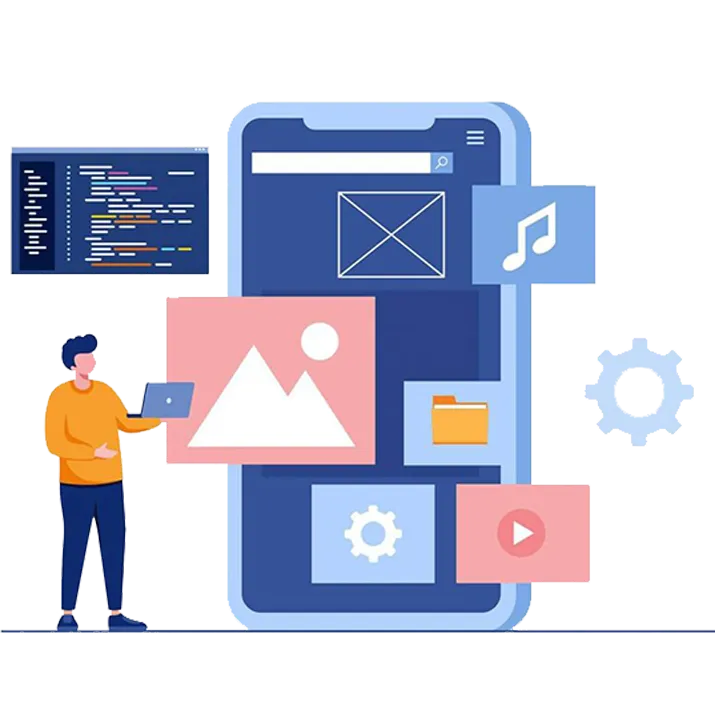Upscale Your Business with Custom AppDevelopment!
In today's hyperconnected world, mobile applications are essential for business growth and customer engagement. Our expert app development services help organizations harness the power of mobile technology through customized solutions that drive innovation and efficiency.
If you thinking about creating a mobile app but need help figuring out where to start your journey, you are not alone. There are plenty of different ways to develop a mobile app, and it is essential to figure out the best fit for your project.
If you thinking about creating a mobile app but need help figuring out where to start your journey, you are not alone. There are plenty of different ways to develop a mobile app, and it is essential to figure out the best fit for your project.

Types of AppsWe Provide
Native app, hybrid app, and progressive web app (PWA) development are three main approaches, each with its unique set of benefits. Choosing the right type of development is important for the success of your app, as it can impact factors such as performance, user experience, and cost.
NativeApplications
Native apps represent the gold standard in mobile application development, offering unmatched performance and user experience. These applications, built specifically for individual platforms like iOS or Android, leverage the full potential of device features and operating system capabilities. Native development enables access to the latest platform features, ensuring your app can utilize advanced functionalities like biometric authentication, camera capabilities, GPS integration, and push notifications.
Native apps' superior performance makes them ideal for businesses requiring complex functionalities, heavy data processing, or intensive graphics rendering. Gaming companies, financial institutions, and healthcare providers often choose native development for its robust security features and ability to handle sophisticated operations seamlessly.
Native apps' superior performance makes them ideal for businesses requiring complex functionalities, heavy data processing, or intensive graphics rendering. Gaming companies, financial institutions, and healthcare providers often choose native development for its robust security features and ability to handle sophisticated operations seamlessly.
Benefits

HybridApplications
Hybrid app development bridges the gap between native and web applications, offering a balanced solution that combines cost-effectiveness with cross-platform compatibility. These applications are built using web technologies (HTML5, CSS, and JavaScript) wrapped in a native container, allowing them to run on multiple platforms while maintaining access to device features.
This approach significantly reduces development time and costs, making it an excellent choice for businesses looking to reach both iOS and Android users without maintaining separate codebases. Hybrid apps are particularly well-suited for content-driven applications, enterprise tools, and businesses seeking rapid market entry while maintaining the flexibility to evolve their applications over time.
This approach significantly reduces development time and costs, making it an excellent choice for businesses looking to reach both iOS and Android users without maintaining separate codebases. Hybrid apps are particularly well-suited for content-driven applications, enterprise tools, and businesses seeking rapid market entry while maintaining the flexibility to evolve their applications over time.
Benefits

ProgressiveWeb Applications (PWAs)
Progressive Web Applications represent the latest evolution in web technology, offering a powerful combination of website accessibility and app-like functionality. PWAs provide features traditionally associated with native applications – offline operation, push notifications, and home screen installation while maintaining the universal accessibility of web applications.
This innovative approach eliminates the need for users to download and install applications through app stores, reducing friction in user acquisition while ensuring your application remains consistently updated across all devices. PWAs are especially valuable for e-commerce platforms, news organizations, and service-based businesses looking to provide seamless user experiences across all devices.
This innovative approach eliminates the need for users to download and install applications through app stores, reducing friction in user acquisition while ensuring your application remains consistently updated across all devices. PWAs are especially valuable for e-commerce platforms, news organizations, and service-based businesses looking to provide seamless user experiences across all devices.
Benefits

Key differences between NativeApps,HybridApps,and Progressive Web Apps (PWAs)
Key differences between NativeApps, HybridApps, and ProgressiveWeb Apps (PWAs)
| Aspect | Native Apps | Hybrid Apps | Progressive Web Apps (PWAs) |
|---|---|---|---|
| Development | Written in platform-specific languages (Swift for iOS, Kotlin for Android, and Flutter and React Native for both platforms) | Built using web technologies (HTML, CSS, JS) and wrapped in a native container | Built using standard web technologies (HTML, CSS, JS) |
| Performance | Best performance and speed due to direct hardware access than the native connection; generally slower than the native | Good performance, but is slightly slower | Depends on the browser and internet |
| Platform Access | Full access to device hardware and features | Access to many device features through plugins | Limited access to device features, but improving with new Web APIs |
| Installation | Must be downloaded from app stores | Can be downloaded from app stores | Installed directly from the browser; adds an icon to the home screen |
| Updates | Require user to download updates from the app store | Require app store updates, but web content can be updated instantly | Updates automatically when online |
| Development Cost | Highest – separate codebase for each platform | Medium – single codebase with platform-specific adjustments | Lowest – single codebase works everywhere |
| App Store Presence | Required to be listed in stores | Can be listed in stores | Not listed in traditional app stores |
| Time to Market | Longest development time | Medium development time | Shortest development time |
Industry-SpecificApp Solutions
Why Choose Our App Development Services?
- Expertise across multiple industries and technologies
- Custom solutions tailored to your specific needs
- Agile development methodology
- Dedicated project management
- Comprehensive testing and quality assurance
- Post-launch support and maintenance
- Scalable and future-proof solutions
Technology continues to evolve rapidly, and our development approach ensures your application remains adaptable to future innovations. We incorporate scalable architecture, modular design principles, and forward-compatible technologies to protect your investment and enable future growth.
Whether you're looking to develop a sophisticated native application, a versatile hybrid solution, or an innovative progressive web app, our team brings the expertise and commitment necessary to transform your vision into reality.
Ready to Start Your App Development Journey?
Contact us today to discuss your project requirements and get a free consultation.


